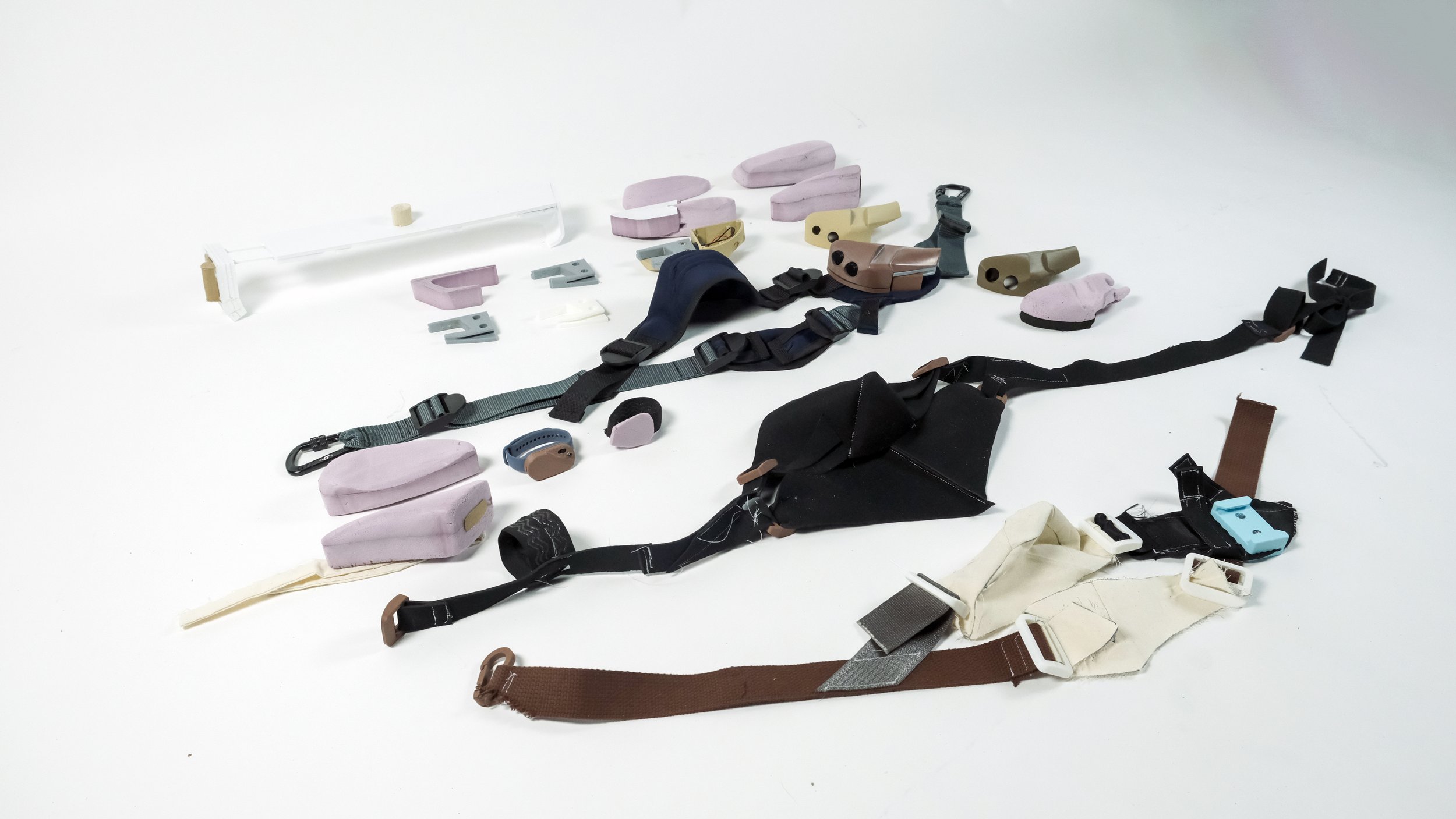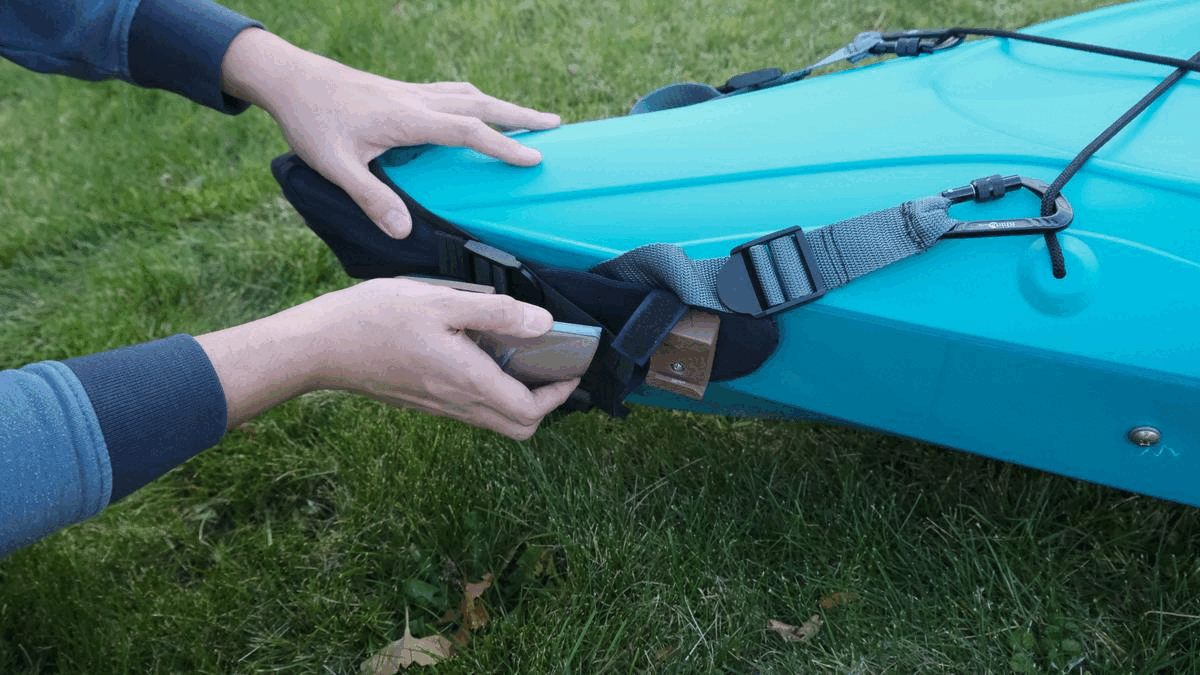
Echo Beneath Safety Beyond
Field: Mobility Design / Sensory Design
Duration: 4 Months Year: 2023
Software Used
An obstacle detection and alerting device to enhance kayaker safety and reduce the risk of collisions with hidden objects or debris as it may lead severe, devastating accidents.
Quick Release Buckle
Sliding bracket mount with secured strap enables device to be mounted and dismounted easily while remained secured. Lengths of heavyweight polypropylene webbings can be adjusted based on the size of kayak bow.
Locking Carabiners
Pre-existing docking lines on all kayaks enable Echo harness to be securely attached. Heavy duty carabiners withstand pulls from fastening the harness on kayak
Ultrasonic Detection
Ultrasonic sensor points forward and downward for maximum coverage on submerged and above-water objects.Range of detection from 16 ft ahead allows 3 seconds of reaction time if going at an average speed of 2 mph
Hands-free alert
Signals from ultrasonic detection delivers to a bracelet via bluetooth to alert kayaker with haptic feedback. Main device and bracelet are connected via bluetooth at all time to alert kayaker with haptic feedback while notifying the battery level.
Adventure with Risks
Kayaking has become one of the most popular water activities in the U.S., with around 18.56 million people participating in 2021. This includes 2.63 million enthusiasts who took part in the more intense sport of whitewater kayaking, which presents greater risks and requires advanced skills.
Understanding the risk in Kayaking
According to the U.S. Coast Guard’s 2022 Recreational Boating Statistics, kayaking accounts for 7% of casualties among all vessel types. Canoes and kayaks together rank second in fatalities, making up 14% of deaths across all vessels. Operator inexperience and hazardous water conditions each contributed to 20% of these incidents. These figures highlight the serious risks associated with kayaking, emphasizing the need for improved safety measures and devices to protect paddlers in unpredictable environments.
Case Study
In September 2023, a Columbia University student tragically lost her life while kayaking on the Potomac River, becoming trapped under a submerged rock she couldn’t avoid in time. This incident underscores the crucial role of rapid sensation and perception in kayaking, as any delay in detecting hazards can leave kayakers with too little time to respond effectively. In environments with unexpected obstacles like rocks or submerged branches, even a slight delay in recognizing the hazard can be fatal, emphasizing the importance of tools and training that enhance quick response.
When Every Second Counts: Risk of Delayed Reactions
Human Reaction Time
Human reaction time (RT) is the interval from stimulus to response, influenced by various factors. Marc Green from West Virginia University Medical School breaks RT into mental processing (sensation, perception, response selection), movement, and device time. Mental processing involves detecting a signal, perceiving it, and choosing a response—such as a kayaker spotting an object and deciding to paddle away. Sensation depends on signal intensity, with tactile stimuli generally yielding the fastest RTs due to the body’s four million receptors. Perception is affected by visibility and complexity, while response selection time can improve with practice
Ultrasonic & Sonar Technology
A fish finder is commonly used by fishermen to efficiently locate specific fish.
Depth finder systems, widely used for measuring water depth and locating underwater features, typically range in price from $120 to $2000.
Sonar and ultrasonic technology, commonly used in marine and land applications, detect distance through soundwave echoes. In water, sound travels at 1500 m/s (4900 ft/s), allowing it to detect objects 20 feet ahead in just 4 microseconds. Products like depth finders, fish finders, underwater vehicles, and parking sensors rely on this technology for detection. In contrast, laser technology, which uses light reflection to measure distance, is unsuitable for underwater applications due to its tendency to be absorbed or scattered by water.
Design Goal
Detecting obstacles during kayaking
Method of alerting kayaker when detecting obstacle within the range
Reducing risk of collision with hidden objects or debris
Essential Design Criteria
Compatibility: Works with a wide range of personal and rental kayaks.
Detection Range: Detects obstacles from 0.1” to 18’ within a 15°-30° angle.
Waterproof & Durable: Built to withstand environmental conditions when securely mounted.
Compact & User-Friendly: Easy to mount and remove before and after sessions.
Hydrodynamic Design: Minimizes water resistance and drag.
Hands-Free Alerts: Allows users to focus on paddling without distractions.
Power Efficient: Optimized for several hours of continuous use.
Regulatory Compliance: Meets IEC 60945 maritime standards.
Affordable: Priced for accessibility without compromising quality.
Building the Technology
Triggering distance is set shorter than actual measuring distance for easier testing.
Programming with Arduino
Transmitter retrieves data from ultrasonic sensor and send it to receiver end via Bluetooth. Receiver then processes the data and follows the condition if it needs to vibrate
Design Concept
Concept I: Stick on
Concept II: Wrap on
Concept III: Clamp On
Three-way anchoring for secure, stable mounting
Neoprene material for high surface friction
Pocket for safe, secure placement on neoprene
Adjustable Velcro strap for a customized fit
Quick and easy mounting and release
Compact and portable design
Waterproof tape or optional screw-in for mounting casing
Adjustable Velcro strap for a secure fit
Single integrated unit with all components in one compact device
Convenient setup for quick and easy installation
EVA foam grip provides high surface friction for secure clamping
Adjustable bracelet for a comfortable and customizable fit
Refined Concept Sketch
Bracelet:
Adjustable Velcro strap for a secure fit
Pairing indicator for connection status
Power switch for easy on/off control
Main Device:
Quick-release mounting for easy attachment and removal
Charging indicator to display battery status
Power switch for convenient operation
Ultrasonic sensor for accurate obstacle detection
Harness:
Center cutout design to reduce water drag
Adjustable positioning for optimal device alignment
Durable neoprene fabric for reliable outdoor performance
Carabiners for secure attachment to deck lines
In-Depth Kayak Research
Once the final concept was decided, I conducted in-depth research on various kayak types and shapes to inform the development of my design. Recognizing that kayak bow sharpness varies by use, I focused on the most popular whitewater kayaks made from rotational molded HDPE. Understanding the material I’d be attaching to helped guide my choice of compatible materials for the device.
Stakeholder Feedback
Emily Reyes
28 yrs old, Female / Elementary School Teacher
Manhattan, New York
Mark Simmons
35 yrs old, Male / Employee at Dick’s Sporting Goods
Woodbridge, New Jersey
Jeremy Oyen
42 yrs old, Male / ACA Instructor Trainer
Chesapeake Bay, Maryland
“An alert system for hidden obstacles would completely change my experience on the water. Right now, I’m constantly scanning for submerged rocks or branches, so a device like this would let me finally relax and enjoy the paddle. I’d want it to be simple and unobtrusive, something I can rely on without even thinking about it.”
“Most customers focus on essentials like paddles, life jackets, and dry bags, but there’s almost no dedicated safety device for kayaking beyond basic life vests. Compared to other sports with helmets, impact vests, and even wearable tech for emergencies, kayaking safety gear is limited. An obstacle alert system could fill this gap and give beginners more confidence on the water.”
“As an ACA instructor, I see how newer paddlers often miss hidden hazards, something even seasoned kayakers can struggle with. A real-time alert system would boost safety and build confidence, helping new kayakers focus on skill-building without the constant worry of unseen obstacles.”
Phase I: Kayak Bow Prototype
Creating a kayak bow replica by carefully carving insulation foam, setting the foundation for later prototype mockups and further development. This process allows for a precise study of form and structure, helping to ensure the device will fit and function optimally on real kayaks
Phase II: Pattern Making for Harness
Phase III: Cad MOdeling & color study
Phase IV: Sewing harness
Binding and finishing on neoprene fabric
Sewing on heavyweight webbing
Electronics Assembly

Material Choices
Harness
Neoprene Fabrics
Heavyweight PP Webbings
POM Plastic Slide Buckles
Heavy Duty Locking Carabiners
Main Device
Injection Molded HDPE Casing
Casing PP Quick Release Buckle
Bracelet
Injection Molded PE Casing
Silicone Strap




















































